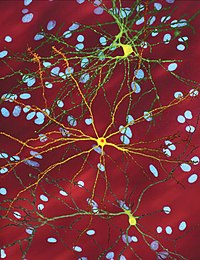
Photo from wikipedia
Huntington's disease (HD) is caused by an expanded CAG repeat in the huntingtin (HTT) gene, translating into an elongated polyglutamine stretch. In addition to the neurotoxic mutant HTT protein, the… Click to show full abstract
Huntington's disease (HD) is caused by an expanded CAG repeat in the huntingtin (HTT) gene, translating into an elongated polyglutamine stretch. In addition to the neurotoxic mutant HTT protein, the mutant CAG repeat RNA can exert toxic functions by trapping RNA-binding proteins. While few examples of proteins that aberrantly bind to mutant HTT RNA and execute abnormal function in conjunction with the CAG repeat RNA have been described, an unbiased approach to identify the interactome of mutant HTT RNA is missing. Here, we describe the analysis of proteins that preferentially bind mutant HTT RNA using a mass spectrometry approach. We show that (I) the majority of proteins captured by mutant HTT RNA belong to the spliceosome pathway, (II) expression of mutant CAG repeat RNA induces mis-splicing in a HD cell model, (III) overexpression of one of the splice factors trapped by mutant HTT ameliorates the HD phenotype in a fly model and (VI) deregulated splicing occurs in human HD brain. Our data suggest that deregulated splicing is a prominent mechanism of RNA-induced toxicity in HD.
Journal Title: Journal of molecular biology
Year Published: 2019
Link to full text (if available)
Share on Social Media: Sign Up to like & get
recommendations!